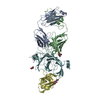+Search query
-Structure paper
| Title | Enhanced potency of an IgM-like nanobody targeting conserved epitope in SARS-CoV-2 spike N-terminal domain. |
|---|---|
| Journal, issue, pages | Signal Transduct Target Ther, Vol. 9, Issue 1, Page 131, Year 2024 |
| Publish date | May 13, 2024 |
 Authors Authors | Bo Liu / Honghui Liu / Pu Han / Xiaoyun Wang / Chunmei Wang / Xinxin Yan / Wenwen Lei / Ke Xu / Jianjie Zhou / Jianxun Qi / Ruiwen Fan / Guizhen Wu / Wen-Xia Tian / George F Gao / Qihui Wang /  |
| PubMed Abstract | Almost all the neutralizing antibodies targeting the receptor-binding domain (RBD) of spike (S) protein show weakened or lost efficacy against severe acute respiratory syndrome coronavirus 2 (SARS- ...Almost all the neutralizing antibodies targeting the receptor-binding domain (RBD) of spike (S) protein show weakened or lost efficacy against severe acute respiratory syndrome coronavirus 2 (SARS-CoV-2) emerged or emerging variants, such as Omicron and its sub-variants. This suggests that highly conserved epitopes are crucial for the development of neutralizing antibodies. Here, we present one nanobody, N235, displaying broad neutralization against the SARS-CoV-2 prototype and multiple variants, including the newly emerged Omicron and its sub-variants. Cryo-electron microscopy demonstrates N235 binds a novel, conserved, cryptic epitope in the N-terminal domain (NTD) of the S protein, which interferes with the RBD in the neighboring S protein. The neutralization mechanism interpreted via flow cytometry and Western blot shows that N235 appears to induce the S1 subunit shedding from the trimeric S complex. Furthermore, a nano-IgM construct (MN235), engineered by fusing N235 with the human IgM Fc region, displays prevention via inducing S1 shedding and cross-linking virus particles. Compared to N235, MN235 exhibits varied enhancement in neutralization against pseudotyped and authentic viruses in vitro. The intranasal administration of MN235 in low doses can effectively prevent the infection of Omicron sub-variant BA.1 and XBB in vivo, suggesting that it can be developed as a promising prophylactic antibody to cope with the ongoing and future infection. |
 External links External links |  Signal Transduct Target Ther / Signal Transduct Target Ther /  PubMed:38740785 / PubMed:38740785 /  PubMed Central PubMed Central |
| Methods | EM (single particle) |
| Resolution | 2.81 Å |
| Structure data | EMDB-36672, PDB-8jva: |
| Chemicals |  ChemComp-NAG: |
| Source |
|
 Keywords Keywords |  VIRAL PROTEIN/IMMUNE SYSTEM / VIRAL PROTEIN/IMMUNE SYSTEM /  complex / complex /  VIRAL PROTEIN-IMMUNE SYSTEM complex VIRAL PROTEIN-IMMUNE SYSTEM complex |
 Movie
Movie Controller
Controller Structure viewers
Structure viewers About Yorodumi Papers
About Yorodumi Papers








